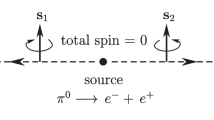An approach to the quantum description of the orientation of relativistic particles, generalizing the approach to nonrelativistic objects possessing orientation (in particular, a rotator) is proposed, based on the self-consistent use of two reference frames. The realization of such an approach is connected with the introduction of wave functions f (x, z) on the Poincaré group M(3,1), which depend on the coordinates x μ of the Minkowski space M(3,1)/Spin(3,1) and orientational variables assigned by the elements z αβ of the matrix Z ∈Spin(3,1).The field f (x, z) is the generating function for ordinary spin-tensor fields and admits a number of symmetries. Besides the Lorentz transformations (corresponding to the action of the Poincaré group from the left and interpretable as external symmetries), transformations of a reference frame associated with an orientable object (corresponding to the action of the Poincaré group from the right and interpretable as internal symmetries) are applicable to orientable objects. In addition to the six quantum numbers assigned by the Casimir operators and the left generators, quantum numbers arise here that are assigned by the right generators and are associated with internal symmetries. The assumption that the internal symmetries of the theory of orientable objects are local leads to gauge theories describing the electroweak and gravitational interactions.
Similar content being viewed by others
References
V. L. Ginzburg and I. E. Tamm, Zh. Eksp. Teor. Fiz., 17, 227–237 (1947).
V. Bargmann and E. P. Wigner, Proc. Nat. Acad. USA, 34, 211–223 (1948).
H. Yukawa, Phys. Rev., 77, No. 2, 219–226 (1950).
Yu. M. Shirokov, Zh. Eksp. Teor. Fiz., 21, No. 6, 748–760 (1951).
D. Finkelstein, Phys. Rev., 100, No. 3, 924–931 (1955).
F. Lurçat, Physics, 1, 95 (1964).
H. Bacry and A. Kihlberg, J. Math. Phys., 10, No. 12, 2132–2141 (1969).
A. Kihlberg, Ann. Inst. Henri Poincaré, 13, No. 1, 57–76 (1970).
M. Toller, Nuovo Cim., B44, No. 1, 67–98 (1978).
S. M. Kuzenko, S. L. Lyakhovich, and A.Yu. Segal, Int. J. Mod. Phys., A10, No. 10, 1529–1552 (1995).
S. L. Lyakhovich, A. Yu. Segal, and A. A. Sharapov, Phys. Rev., D54, No. 8, 5223–5238 (1996).
W. Drechsler, J. Math. Phys., 38, No. 11, 5531–5558 (1997).
V. V. Varlamov, Int. J. Mod. Phys., A20, 4095–4112 (2005) [arXiv:math-ph/0310051].
D. M. Gitman and A. L. Shelepin, Int. J. Theor. Phys., 40, 603–684 (2001) [arXiv:hep-th/0003146].
I. L. Buchbinder, D. M. Gitman, and A. L. Shelepin, Int. J. Theor. Phys., 41, No. 4, 753–790 (2002). [arXiv:hep-th/0010035].
D. M. Gitman and A. L. Shelepin, Eur. Phys. J., C61, No. 6, 111–139 (2009) [arXiv:hep-th/0901.2537].
D. M. Gitman and A. L. Shelepin, Physica Scripta, 83, 015103 (2011) [arXiv:1001.5290].
D. M. Gitman and A. L. Shelepin, Physica Scripta, 84, 055101 (2011).
A. O. Barut and R. Raczka, Theory of Group Representations and Applications, PWN, Warsaw (1977).
D. M. Gitman, D. A. Petrusevich, and A. L. Shelepin, J. Phys., A47, 275401 (2014).
L. S. Biedenharn and J. D. Louck, Angular Momentum in Quantum Physics, J. Wiley & Sons, New York (1981).
R. N. Zare, Angular Momentum. Understanding Spatial Aspects in Chemistry and Physics, J. Wiley & Sons, New York (1988).
E. P. Wigner, Ann. Math., 40, No. 1, 149–204 (1939).
S. Coleman and J. Mandula, Phys. Rev., 159, No. 5, 1251–1256 (1967).
F. Gronvald and F. W. Hehl (1996) [arXiv: gr-qc/9602013].
F. W. Hehl and Yu. N. Obukhov, Annales de la Fondation Louis de Broglie, 32, No. 1–2, 157–194 (2007). [arXiv:0711.1535 [gr-qc]].
R. Aldrovandi and J. G. Pereira, An Introduction to Teleparallel Gravity: Lecture Notes (2007 (unpublished); available from: http://www.ift.unesp.br/gcg/tele.pdf.
Author information
Authors and Affiliations
Corresponding author
Additional information
Translated from Izvestiya Vysshikh Uchebnykh Zavedenii, Fizika, No. 11, pp. 197–203, November, 2016.
Rights and permissions
About this article
Cite this article
Gitman, D.M., Shelepin, A.L. Orientable Objects in Relativistic Quantum Theory. Russ Phys J 59, 1962–1970 (2017). https://doi.org/10.1007/s11182-017-1002-1
Received:
Published:
Issue Date:
DOI: https://doi.org/10.1007/s11182-017-1002-1




